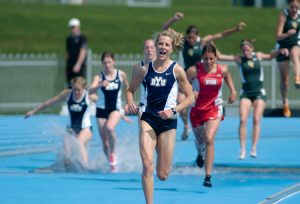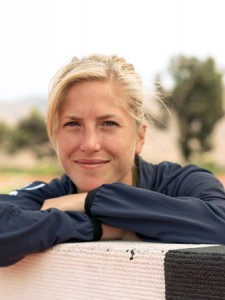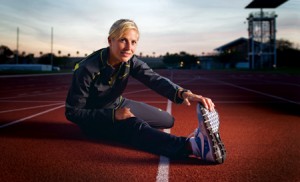With pain in her past, runner Kassi Andersen is focused on the hurdles ahead of her.
Legs pumping, Kassi Andersen (BS ’04) toiled atop her bicycle up the winding switchbacks of the Alpine Loop, a narrow road that snakes along the back side of Mt. Timpanogos. It was the Saturday of Labor Day weekend 2004. Andersen, the 2003 national champion steeplechaser from BYU, was cross-training to keep in shape for the cross country season, just weeks away, while her foot finished healing from an injury sustained during a race that summer.
Andersen’s older brother and training partner Jacob (BS ’04) rode just ahead. But Kassi kept some distance between them, not wanting to draft. She preferred to brave the wind and add one more degree of difficulty to the 3,000-foot climb above Utah Valley.
When the road finally leveled, the pair stepped off their bicycles to rest their legs and take in the yellow of the early-autumn Aspen leaves. They weren’t the only ones admiring the view. The holiday weekend brought a stream of vehicles loaded with sightseers who shared the narrow asphalt strip. Before climbing back onto their bikes to coast down the Provo Canyon side of the loop, Jacob reminded Kassi to go slowly on the switchbacks.
But the descent was steep and the road slick from a cool rain. Despite her precautions, Kassi soon rounded a blind turn and found herself directly in the path of a truck pulling a camp trailer. She swerved and hit the brakes too hard, sending her body over the handlebars, onto the pavement, and under the rear wheel of the trailer.
Four years later, Andersen is at the Olympic Training Center in Chula Vista, Calif., rehabbing yet another injury, and that fateful bike ride now seems a distant chapter of the journey that has brought her back from a near tragedy to the wings of the world’s biggest sports stage. With her eyes on the next big race—the 2008 Olympic Trials for steeplechase in July—Andersen doesn’t dwell on the past. In fact, at the invitation-only facility, it seems that neither her friends among the other 200 Olympic hopefuls nor the sports-medicine staff know about her accident or recovery. All they know is a very determined runner.
“I have always thought there is a lot more in me, that I am not done. I’ve always known I could go a lot faster, even when I finish my fastest race,” says Andersen. “I want it so bad and it won’t leave me. It’s not like, ‘Yeah, it’s just me and I’m really competitive.’ It’s like this dream that God put in my heart, and it won’t let go.”
The Road Back
The wheel of the camper ran over the left side of Andersen’s body.
“I cried out in frustration and knew right away that something was broken,” recalls Andersen, who remained conscious through the entire painful ordeal. In fact, she had broken both her elbow and her pelvis.
BYU women’s cross country coach Patrick E. Shane (BS ’70) got the call about the accident from Andersen’s sister, who said Kassi was being taken to Utah Valley Regional Medical Center. Shane and the Andersen family actually arrived before the ambulance.
“At the time, you are not even thinking of athletics,” says Shane. “Your whole focus is on this wonderful human being that is hurt and is in pain. It never entered my mind until I got home and I realized, ‘Oh, my number one runner won’t be running for me.’”
The prospect of never running again hadn’t escaped Andersen. “I had no idea what was going to happen or if I would compete or even run again,” she says. Following surgery, however, her doctor had encouraging news: he expected a complete, if lengthy, recovery. The doctor said it would be six to eight months before she ran again. But Andersen was eager to keep moving forward. The day after surgery, she took her first steps with the aid of a walker, which she used to get around campus until she could walk unaided. Two months after the accident she was working out on an underwater treadmill.
By December, X-rays showed the fracture had completely healed and doctors cleared Andersen to start running, just three months after the injury. Her first attempt was around BYU’s indoor track in the Smith Fieldhouse, where she slowly jogged about two miles. A week later she was running outdoors.
“My first run was so amazing,” remembers Andersen. “I just cried the whole time, so thankful to run again.”
Soon after Andersen was on a progressive training program designed by Coach Shane and A. Kevin Morris (BS ’92), a BYU athletic trainer and associate clinical professor of exercise sciences.
“It takes a tremendous work ethic and attitude to participate in the steeplechase, let alone be a national champion,” says Morris. “But to suffer a serious injury as Kassi did would make most athletes quit. Kassi has the physical toughness, as well as the mental toughness, required to overcome any injury.”

As an undergraduate researcher, Andersen studied the tricky water jump. She and mentor lain Hunter found tha technique was less important than approaching the barrier at high speed.
The Science of Steeplechase
In the corner of a room at the Olympic Training Center, Andersen runs on a machine that looks like a treadmill in a bubble. Called the G-Trainer, this pricey piece of equipment helps Andersen run without aggravating her injured left foot. Early in the year she had run twice in racing spikes that made her calves sore, leading to a poor running motion and inflammation in the tissue connecting to her heel bone.
She wears a pair of running shorts that zip onto the top of the bubble, forming an air-tight chamber around her legs and the treadmill. After the machine reads her weight, Andersen dials up the air pressure inside the chamber to reduce the impact of each stride. For this workout, Andersen adjusts the settings to run at 80 percent of her actual body weight. To compensate for the lighter stride, she runs faster than if she were out on the track, keeping an eye on the heart-rate monitor.
“It feels like I’m floating,” she says at the end of the morning run.
Andersen and other athletes at the training facility are surrounded by high-tech equipment and training techniques developed in the science of sport. Andersen has special appreciation for such advances: not only does she benefit from the scientific progress, she has actually contributed to it in the lab.
As an undergraduate fitness and wellness-management student, Andersen was a research assistant for BYU associate professor Iain Hunter (BA ’96), who also serves as a designated biomechanist for USA Track & Field. Hunter had received funding to study steeplechase, a track-and-field oddity with its seven and a half laps—each featuring four hurdles and one 12-foot-long water pit. Hunter’s objective was to determine the optimal techniques for the water jump, the trickiest part of the course.
Hunter’s first assignment for Andersen was to look, frame by frame, at film of runners as they approached and cleared the water barrier. For each frame, Andersen placed a dot on the runner’s toes, heels, knees, hips, hands, elbows, shoulders, and neck. The sequence of marked-up frames, shot from three camera angles, allowed Hunter and Andersen to statistically determine the motions that work best. To their surprise, they found that technique is not nearly as important as approaching the barrier at high speed.
Hunter says Andersen performed seven times the workload expected of a typical research assistant in her work on this project.
“If I’m going to invest in something,” Andersen says simply, “I’m going to be good at it and do my best.”
Her efforts were rewarded when Andersen, as a graduate student, presented the findings at the 2005 annual meeting of the American College of Sports Medicine in Nashville, Tenn. An expanded report on their work was published in June 2008 in the Journal of Sports Science and Medicine, with Andersen as a coauthor.
The conference in Nashville also marked a symbolic milestone in Andersen’s path to physical recovery: just nine months after her accident she won the women’s 5K race organized for conference attendees. That small victory lies somewhere between requiring the assistance of a walker and turning pro with a contract from Nike.
Desire and Grit
The camaraderie among athletes at the Olympic Training Center is evident in the noisy chatter filling the cafeteria at lunchtime. Today’s menu includes Filipino dishes like sinigang beef, pancit noodles, and chicken adobo, served in honor of the visiting Philippine Olympic Committee. A group of 6-foot-and-over women from the rowing team sit down next to Andersen and talk about their last trip to the beach.
This is not the first time Andersen has been among such elite athletic company. Though women’s steeplechase was not an official event in the Athens Olympics, the race was included in the 2004 Olympic Trials—Andersen’s last race before her accident. Her performance in that race revealed the depths of her competitive drive.
In the final lap of the final heat, Andersen was running in second place and was on pace for a new personal best time. She cleared the water jump but landed awkwardly on her leading right foot. The landing sprained her ankle and fractured a few bones in her foot, but Andersen kept running.
 Eyeing the one hurdle still between her and the finish line, Andersen braced for another shot of pain. She cleared the hurdle, but this second landing felt worse than the one that caused the injury.
Eyeing the one hurdle still between her and the finish line, Andersen braced for another shot of pain. She cleared the hurdle, but this second landing felt worse than the one that caused the injury.
From the sidelines, Coach Shane knew Andersen was running hurt. That she finished at all, he says, is due to her incredible determination. “I may never get another one quite like her. She’s an inspiring story.”
Crossing the finish line third, Andersen was carried off the track as her foot quickly ballooned. Officially she placed second because of another runner’s disqualification. If her foot had held up, perhaps she would have won.
Just as the foot injury didn’t cut short her race, it didn’t derail Andersen’s longer-term training plan, looking forward to 2008, when steeplechase would make its Olympic debut. She quickly adopted a cross-training regimen to keep in shape as her foot healed. It was the same training plan that led Andersen and her brother to bike the Alpine Loop on Labor Day weekend.
Looking Ahead
For her afternoon workout, Andersen does a series of flexibility drills on the Olympic Training Center track, which overlooks a lake where the rowers practice. Under Coach Terrance Mahon, Andersen’s winter routines were designed to build up resistance to injuries. Now she’s adding more hurdle drills, followed by several races leading up to the trials.
“If we can get Kassi to the line healthy and ready to race, then I think that she has as good a shot at making the Olympic team as any of America’s current top steeplechasers,” Mahon says.
In between drills, Andersen takes a break and discusses the crowd of runners she will compete against in July, putting them in three categories. There’s the handful of runners who dominated last season. Next is a group of more veteran runners. Then comes the crop of newcomers that nobody recognizes, at least not yet. Andersen predicts that one of these unknowns will make a name for themselves with a strong performance.
“I don’t think many runners have their eye on me because I’ve been out of the limelight for a while,” Andersen says, though she was named an All-American in both 2006 and 2007. “It doesn’t bother me. As long as you are there when it counts, it doesn’t matter what you did a year ago or three months ago.”
Those sentiments, and the determination that fueled her journey back to the track, strike a familiar chord: all that matters is gaining enough speed for the barrier that’s in front of you.
Joseph Hadfield is a media relations manager for BYU’s University Communications.
Note: As this magazine was nearing press time, Andersen competed in the Olympic trials. See “Being More,” to read how she fared.
Feedback: Send comments on this article to magazine@byu.edu.







